Private sales and alternative art fairs are reshaping the art market by offering discreet, innovative ways to buy and showcase art outside traditional galleries and auctions. These channels provide greater control, privacy, and direct engagement with collector networks, often emphasizing curatorial innovation and digital integration. While they increase accessibility and global visibility, concerns about transparency and market consolidation remain. To understand how these shifts impact artists and collectors alike, explore what these evolving dynamics mean for the future of art commerce.
Key Takeaways
- Private sales offer discreet transaction options, enhancing confidentiality and control for collectors and artists.
- Alternative art fairs promote accessible, curated spaces that foster deeper engagement and showcase emerging talent.
- These channels can obscure provenance and pricing, raising transparency and market fairness concerns.
- Market consolidation and gatekeeper influence may limit opportunities for smaller galleries and new artists.
- Digital integration and innovative platforms are reshaping visibility, emphasizing curated online presence over broad public access.
The Rise of Private Sales in the Art Market

Private sales have become an increasingly prominent aspect of the art market, offering collectors and dealers a discreet alternative to public auctions and exhibitions. They provide a way to navigate market transparency concerns, as buyers often seek confidentiality and control over their transactions. Private sales can help protect buyer interests by enabling discreet negotiations and reducing exposure to volatile auction prices. This method allows you to acquire or sell art without the public scrutiny that comes with traditional sales channels, giving you peace of mind and confidentiality. Additionally, understanding the market dynamics can help participants make more informed decisions in these private transactions. As the art world evolves, private sales are gaining popularity because they address key issues like market transparency and buyer protection, making them an attractive option for those seeking a secure, private transaction environment.
How Alternative Art Fairs Are Changing the Exhibition Landscape
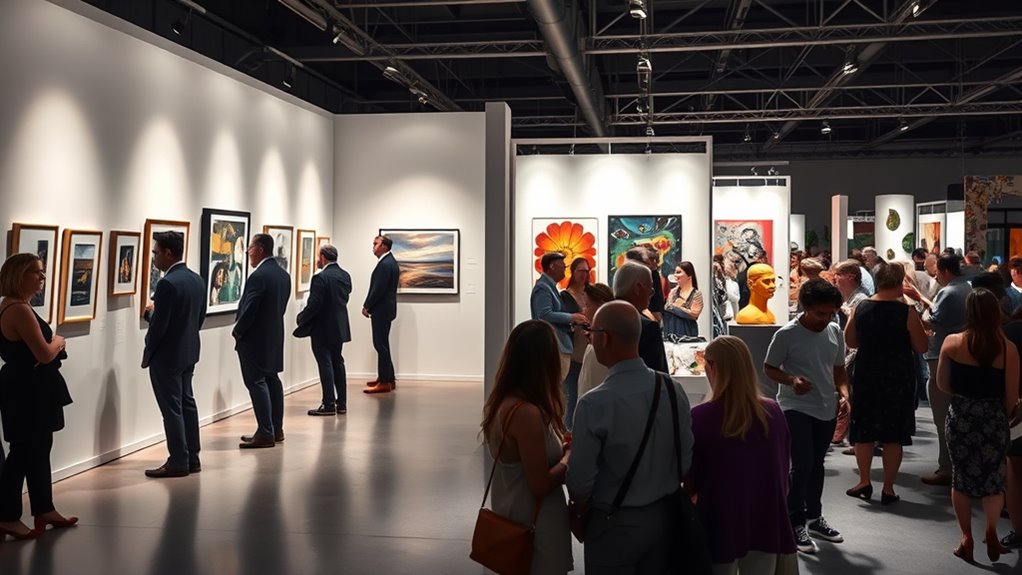
Alternative art fairs are reshaping the exhibition landscape by offering more flexible, accessible, and innovative platforms for artists and collectors. They prioritize curatorial innovation, presenting diverse and dynamic artworks that challenge traditional formats. This approach allows you to experience art in new contexts, fostering deeper audience engagement beyond the conventional gallery setting. You’re encouraged to interact directly with works and artists, creating a more personalized and immersive experience. These fairs often feature innovative layouts, digital integrations, and thematic curations that draw in wider audiences. By breaking down barriers of location, cost, and formality, alternative art fairs democratize access to art, making it easier for you to discover emerging talent and engage meaningfully with contemporary practices. They’re fundamentally transforming how art is exhibited, experienced, and appreciated. Incorporating essential oils into the experience can enhance your mood and focus as you explore new art spaces.
Comparing Traditional Galleries and New-Age Platforms
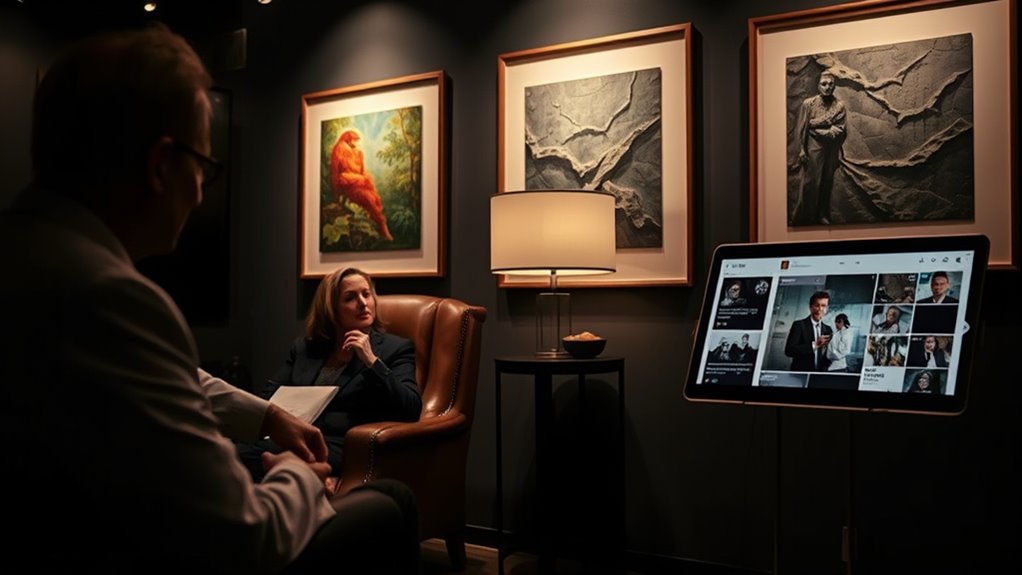
You’ll notice that new-age platforms often offer greater accessibility and a broader reach than traditional galleries. However, questions about authenticity and trust still linger with these digital spaces. It’s important to weigh how each approach balances openness with reliability in today’s art market. Incorporating body awareness techniques from somatic therapy can help collectors and artists develop a more nuanced understanding of physical cues and emotional responses, fostering greater confidence in their interactions within these evolving platforms.
Accessibility and Reach
Traditional galleries have long held the advantage of physical proximity, making art accessible to local audiences but often limiting reach beyond their immediate community. However, collector behavior is evolving, with many seeking broader access through online platforms. New-age platforms expand visibility, allowing you to explore diverse artworks without geographical constraints. This shift encourages gallery collaboration, where digital spaces complement physical exhibitions and reach global audiences more effectively. As a result, accessibility isn’t just about location anymore; it’s about seamless online engagement that caters to your preferences. You can now connect with galleries worldwide, view collections virtually, and make purchases remotely. These digital innovations democratize art access, broadening your reach and enabling you to discover works previously out of reach, all while maintaining direct relationships with galleries. Additionally, the development of projector technology has made home viewing more immersive, allowing art and visual content to be experienced in new and engaging ways at home.
Authenticity and Trust
While digital platforms offer unparalleled convenience, questions about authenticity and trust remain at the forefront. You need to contemplate how each platform maintains artistic integrity and verifies provenance. Traditional galleries often have established reputations, rigorous provenance verification processes, and direct relationships with artists, fostering trust. In contrast, new-age platforms may lack these safeguards, making it harder to confirm an artwork’s authenticity. However, many are adopting advanced technology like blockchain to improve provenance verification and enhance transparency. As a buyer, you should scrutinize the platform’s credibility and ask for detailed documentation. Ultimately, trust hinges on how well the platform protects artistic integrity and ensures accurate provenance, whether through tradition or innovative verification methods. Additionally, understanding the regulatory frameworks that govern art sales can help you navigate legal protections and verify legitimacy.
The Role of Technology in Facilitating Private Transactions
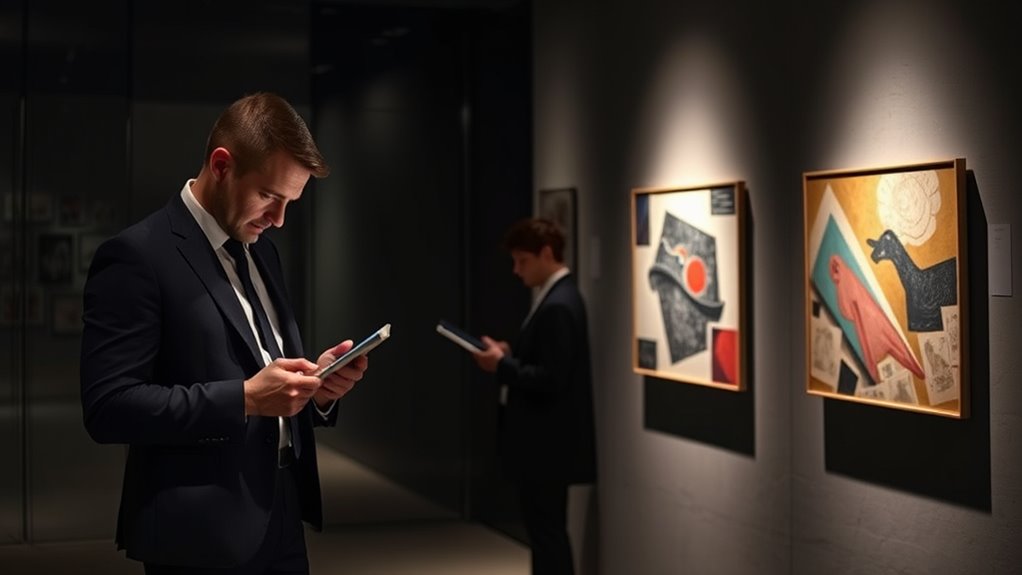
Technology has revolutionized how private art transactions occur, making the process faster, more secure, and more accessible. Digital authentication guarantees the provenance and authenticity of artworks, giving buyers confidence and reducing fraud risks. Online bidding platforms enable you to participate in private sales from anywhere, expanding your options and flexibility. These tools streamline negotiations and reduce the need for physical meetings, saving time and effort. Secure payment systems add an extra layer of protection, fostering trust between buyers and sellers. As a result, technology simplifies complex transactions, making private sales more efficient and transparent. You can now access a broader market, verify artworks with ease, and complete deals swiftly—all thanks to these innovative technological solutions. Incorporating security features further enhances the reliability of digital transactions, reassuring both buyers and sellers.
Impact on Artists and Their Market Strategies
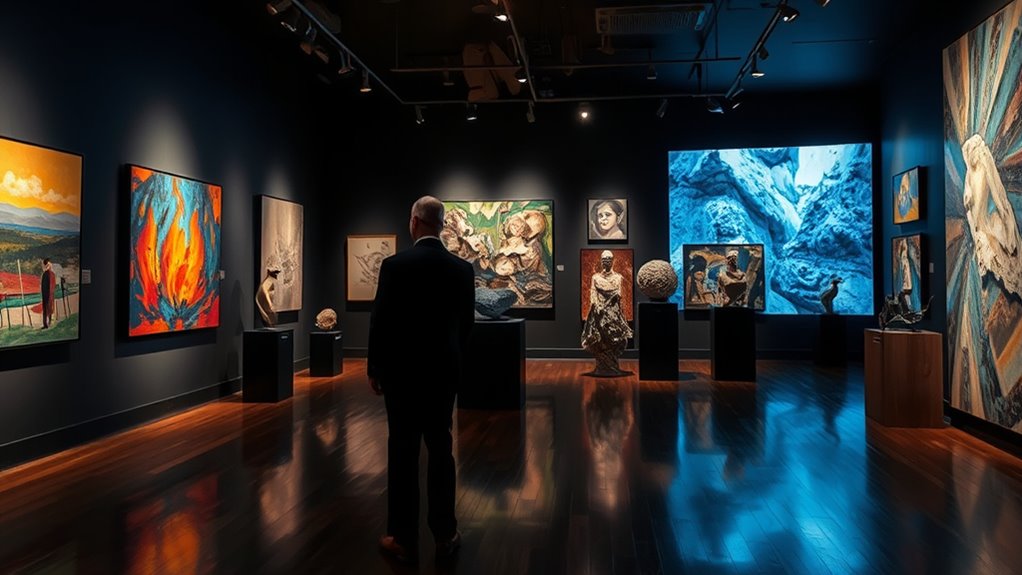
Private sales give you more control over your market presence, allowing you to choose where and how your work is seen. This shift can reduce your visibility in traditional channels, making it harder to reach new audiences. You need to adapt your strategies to stay connected and maintain your reputation in this changing landscape. Incorporating somatic therapy techniques can also help artists manage the stress and uncertainty associated with these evolving market dynamics.
Enhanced Market Control
Enhanced market control through private sales and alternative art fairs gives collectors and intermediaries more power to influence prices and access. This shift can lead to market monopolization, where a few key players dominate sales, making it harder for artists to reach diverse audiences. With exclusive access to high-value transactions, collectors and intermediaries steer pricing and visibility, limiting opportunities for emerging artists or less connected creators. As a result, artists may feel pressured to tailor their market strategies toward these gatekeepers, prioritizing relationships with insiders over broad exposure. This dynamic consolidates control in fewer hands, reducing transparency and competition. Ultimately, enhanced market control can challenge artists’ independence, pushing them to adapt their practices to meet the preferences of those wielding significant influence. Understanding asset division laws and strategies can help artists navigate the shifting landscape and protect their interests in a consolidating market.
Shift in Visibility
As private sales and alternative art fairs reshape how artworks gain visibility, artists find their exposure increasingly tied to the interests of powerful gatekeepers rather than broad audiences. Digital engagement has become a vital tool, allowing artists to connect directly with collector networks and showcase their work beyond traditional venues. However, this shift means that visibility is often curated through select online platforms or exclusive events, limiting broader public access. Artists now need to tailor their market strategies to appeal to these influential gatekeepers who control digital spaces and collector networks. While this can increase prestige and sales within niche circles, it also risks narrowing an artist’s reach, making genuine audience engagement more challenging. Ultimately, visibility depends more on strategic relationships than widespread recognition, emphasizing the importance of market strategies in navigating the evolving art landscape.
Challenges and Criticisms of Emerging Sales Channels

While emerging sales channels like private sales and alternative art fairs offer new opportunities for collectors and artists, they also introduce significant challenges and criticisms. Ethical concerns arise around transparency, as private transactions can obscure provenance and pricing, making it harder to guarantee fair dealings. Additionally, these channels risk fostering market consolidation, where a few dominant players control access and influence, potentially marginalizing smaller galleries and artists. This shift can undermine the diversity of the art market, reducing opportunities for emerging talents. Critics argue that these channels may prioritize profit over public interest, weakening trust and accountability. As you navigate these new avenues, it’s essential to remain aware of these issues and advocate for practices that promote fairness, transparency, and a healthy, inclusive art ecosystem.
The Future of Art Commerce: Trends and Predictions
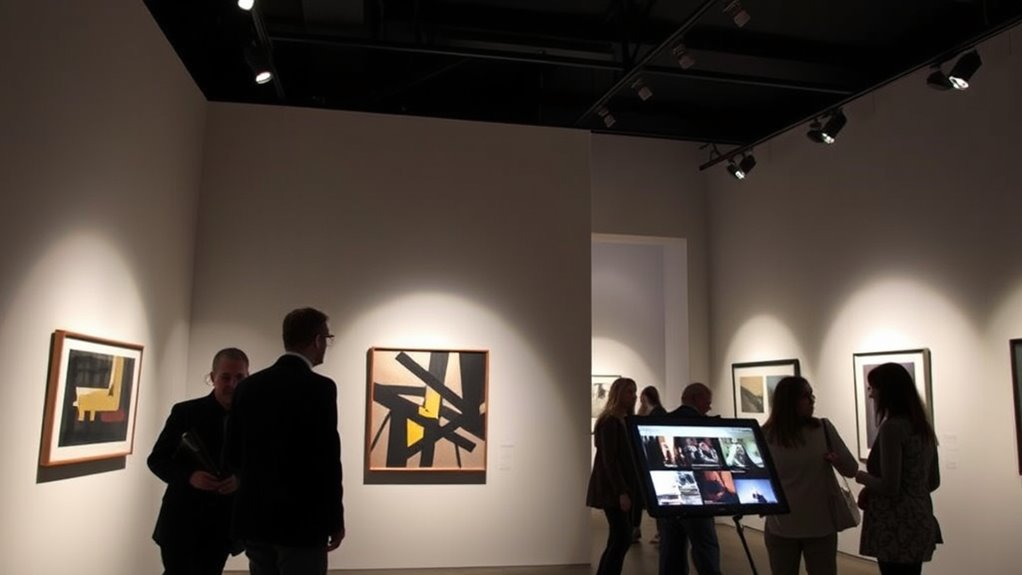
The future of art commerce is poised to be shaped by rapid technological innovations and evolving consumer behaviors. You’ll see a shift toward sustainable practices, as collectors and galleries prioritize environmentally responsible methods and materials. Digital platforms will continue to expand, making art more accessible while promoting transparency in transactions. Cultural preservation will also play a key role, with increased efforts to protect and promote diverse heritages through digital archives and ethical sourcing. Artificial intelligence and blockchain technology will streamline provenance verification and secure ownership records. As you navigate this landscape, expect a more personalized experience driven by data analytics and immersive online exhibitions. Moreover, embracing creative practice can foster innovative approaches to art creation and presentation. Overall, these trends suggest a more sustainable, inclusive, and technologically advanced future for art commerce.
Navigating the Evolving Cultural Ecosystem
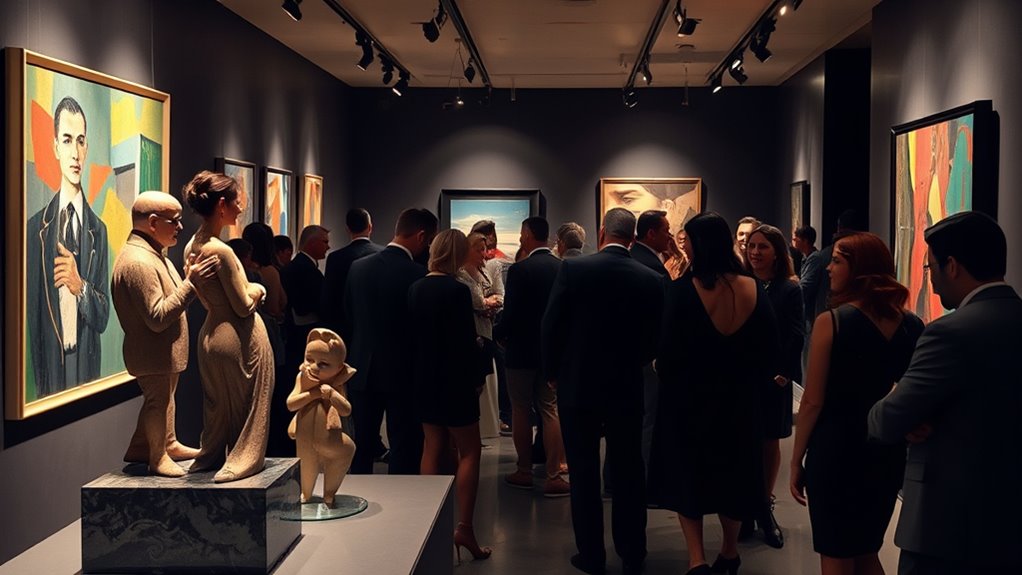
Technological advancements are reshaping how artists, institutions, and audiences engage with art within a dynamic cultural landscape. You now have more opportunities for artistic collaboration across borders, fostering diverse perspectives. These tools also support cultural preservation, ensuring traditions survive amid rapid change. To thrive, you must adapt by embracing digital platforms that connect communities and promote shared heritage. Exploring innovative plant decor ideas can further enhance the cultural dialogue and aesthetic experience.
Frequently Asked Questions
How Do Private Sales Influence Artist Representation and Exposure?
Private sales can limit artist visibility by reducing exposure through traditional gallery channels, especially when gallery exclusivity restricts access. However, they also offer opportunities for tailored marketing, allowing you to reach specific collectors and build strong relationships. By balancing private sales with gallery representation, you can maintain artist visibility while controlling how and when your work is showcased, ultimately shaping your career’s trajectory more deliberately.
What Role Do Alternative Art Fairs Play in Democratizing Art Access?
Alternative art fairs play a essential role in democratizing art access by showcasing emerging artists and fostering community engagement. You get to experience diverse, accessible exhibitions that aren’t confined to traditional galleries, allowing you to discover new talent firsthand. These fairs break down barriers, making art more inclusive, and encourage local participation, giving you a chance to connect directly with artists and broader creative communities, enriching your cultural experience.
Are Digital Platforms Replacing Traditional Gallery Relationships?
Digital platforms are increasingly replacing traditional gallery relationships by offering virtual exhibitions that reach a wider audience. You can now explore art from anywhere and verify authenticity through blockchain authentication, making transactions more transparent and secure. While galleries still hold value, these platforms empower you to connect directly with artists and collectors, transforming how you discover, buy, and enjoy art in a more accessible and innovative way.
How Secure Are Private Transactions Compared to Public Sales?
Imagine slipping a delicate, sealed envelope into a trusted hand—you feel the weight of confidentiality concerns. Private transactions often feel more secure, but they aren’t foolproof. You need robust transaction verification to truly protect your interests. While public sales are transparent, private deals rely on trust and discretion. Ultimately, the security depends on how well you vet the parties involved and guarantee confidentiality concerns are addressed.
What Ethical Concerns Arise From Shifting Art Market Dynamics?
You might worry about authenticity concerns and transparency issues as art market dynamics shift. These changes can make it easier for forgeries to circulate and obscure the provenance of artworks. When transactions happen privately, it’s harder to verify the legitimacy of deals, raising ethical questions about honesty and accountability. You should stay vigilant, insist on proper documentation, and support initiatives promoting transparency to protect both buyers and artists.
Conclusion
As you watch the art world transform, one thing becomes clear: the traditional gallery scene may never be the same. Private sales and alternative fairs open new doors, but they also raise questions about authenticity and accessibility. Will these shifts create more opportunities or deepen divides? The future holds unexpected twists—your role in this evolving landscape could be more pivotal than you think. Are you ready to navigate what’s next?









